Concept of Gender Equity: An Islamic Perspective
DOI:
https://doi.org/10.53762/alqamar.05.03.e11Keywords:
Gender, Equity, Islamic perspectiveAbstract
The concept of equality was not mandatory. The Holy Quran, a complete guide for Muslims, provides clear protection in the areas of marriage, divorce, and inheritance. This is a significant improvement over the situation of women in pre-Islamic societies where women were the burden of the family and women were the burden. Buried alive. Nevertheless, historical circumstances have often put Muslim women at a disadvantage for centuries. Pervasive traditions of male authority and honor make it difficult for women to claim the rights guaranteed in the Quran. Numerous reforms have taken place in this century to improve educational opportunities and promote the emancipation of women in general. However, certain patterns of difficulty still dominate, such as key issues, such as employment and political activity, or issues considered divisive. Western countries viewed Muslim women as "progress" and "problem" problems, pointing to clear inequalities in the relative status of men and women. This study argues that the relationship between women and men is largely incomprehensible unless one tries to examine it from an Islamic perspective. The Quran lists men as protectors of women, and women's justice is defined by their obedience to them. A major theme of modern Islamic scriptures is that women hold power through their innate qualities and traits and have well-defined roles in any society, preserving the roles assigned to men. This is well-explained and expressed for both men and women. Owing to the nature of the situation, it cannot be used appropriately. Their physical and psychological differences determine each individual’s different but complementary duties. Few Muslim women, even those who are critical of the restrictions imposed by Islam, understand many of the things that are considered characteristic of Western feminism. Islam frees women from many of the problems and worries inherited by men; however, women often do not give up this easily.
References
Shultziner, Doron. “Human Dignity-Functions and Meanings.” Global Jurist Topics 3, no. 3 (2004).
Radwa S Elsaman and Mohamed A Arafa, “The Rights of the Elderly in the Arab Middle East: Islamic Theory versus Arabic Practice,” Marq. Elder’s Adviser 14 (2012): 1.
Jawad Syed, “An Historical Perspective on Islamic Modesty and Its Implications for Female Employment,” Equality, Diversity and Inclusion: An International Journal, 2010.
Sumaira T Khan, “Islam and Girls’ Education: Obligatory or Forbidden,” Cultural and Religious Studies 4, no. 6 (2016): 339–45.
Michael Walzer, Politics and Passion: Toward a More Egalitarian Liberalism (Yale University Press, 2006).
Tamer Koburtay, Jawad Syed, and Radi Haloub, “Implications of Religion, Culture, and Legislation for Gender Equality at Work: Qualitative Insights from Jordan,” Journal of Business Ethics 164 (2020): 421–36.
Beverly Dawn Metcalfe, “Women, Empowerment and Development in Arab Gulf States: A Critical Appraisal of Governance, Culture and National Human Resource Development (HRD) Frameworks,” Human Resource Development International 14, no. 2 (2011): 131–48.
Farzana Bari, “Women Parliamentarians: Challenging the Frontiers of Politics in Pakistan,” Gender, Technology and Development 14, no. 3 (2010): 363–84.
Anita M Weiss, “Interpreting Islam and Women’s Rights: Implementing CEDAW in Pakistan,” International Sociology 18, no. 3 (2003): 581–601.
Ms Meena Sharify-Funk, Encountering the Transnational: Women, Islam and the Politics of Interpretation (Ashgate Publishing, Ltd., 2013).
Judith Lorber, “Gender Inequality,” Los Angeles, CA: Roxbury, 2001.
Bushra Mahzabeen, “Petro-Culture as an Oppressor of Women and Nature: An Ecofeminist Reading of Nawal El Saadawi’s Love in the Kingdom of Oil,” A Journal of English Studies 9 (2018).
Afshana Haque et al., “Microaggressions and Islamophobia: Experiences of Muslims across the United States and Clinical Implications,” Journal of Marital and Family Therapy 45, no. 1 (2019): 76–91.
Md Maruf Ullah, Taskina Binta Mahmud, and Fatema Yousuf, “Women Entrepreneurship: Islamic Perspective,” European Journal of Business and Management 5, no. 11 (2013): 44–52.
Jamal A Badawi, Gender Equity in Islam, vol. 2 (by IDM Publications, 1995).
Jasmin Zine, “Unveiled Sentiments: Gendered Islamophobia and Experiences of Veiling among Muslim Girls in a Canadian Islamic School,” Equity & Excellence in Education 39, no. 3 (2006): 239–52.
Sherene H Razack, “Imperilled Muslim Women, Dangerous Muslim Men and Civilised Europeans: Legal and Social Responses to Forced Marriages,” Feminist L. Stud. 12 (2004): 129.
Anne Johanna Tuppurainen, “Challenges Faced by Muslim Women: An Evaluation of the Writings of Leila Ahmed, Elizabeth Fernea, Fatima Mernissi and Amina Wadud,” 2010.
Nikki R Keddie, Women in the Middle East: Past and Present (Princeton University Press, 2012).
Carmen Diana Deere and Cheryl R Doss, “The Gender Asset Gap: What Do We Know and Why Does It Matter?,” Feminist Economics 12, no. 1–2 (2006): 1–50.
Mahnaz Afkhami, Muslim Women and Politics of Participation (Syracuse University Press, 1997).
Published
How to Cite
Issue
Section
Copyright (c) 2022 Al-Qamar

This work is licensed under a Creative Commons Attribution 4.0 International License.


















